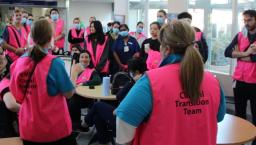AI helps Mount Sinai organize and unlock largely untapped surgical data

Photo: Mount Sinai
There can be significant variability in surgical outcomes today – not only in different parts of the world but even within the same hospital – directly impacting patient care and hospital economics based on complications, readmissions and operative time.
THE PROBLEM
While hospitals understand there is inherent variability in outcomes, ranging from postoperative complications to re-operations, rehospitalizations, length of stay and more, the solution is not clear. Why is this? Some experts say it directly points to data. There is data missing from hospital analyses to assess outcomes.
PROPOSAL
Dr. Ketan Badani is vice chairman of urology and robotics operations at Mount Sinai in New York City. He understood this problem well. And he turned to vendor Theator to help solve the problem.
Theator is a health IT company that leverages proprietary AI to tackle disparity and variability in surgery and improve outcomes.
"Today, there is no way to routinely and automatically capture all minimally invasive and robotic surgical procedures," Badani said. "Existing technologies require staff to remember to press record, and then usually require a thumb drive to download the video from the operating room camera system and upload it to a hard drive.
"The videos then need to be structured in order to conduct any meaningful analysis," he continued. "This process is time-intensive and adds friction to something that technology can solve."
The new AI platform automates the entire process without adding cameras or sensors to the OR. The SaaS technology automatically and routinely captures all minimally invasive and robotic surgical video, de-identifies it, and structures the video with procedural steps. It catalogs intraoperative events (for example, bleeding), safety milestones, procedure complexity and more.
"It goes beyond structuring just procedural steps – it also analyzes the complexity of each case, when any intraoperative event such as bleeding occurs, when safety milestones are achieved, when the camera is out-of-body and more," Badani explained.
"To truly understand the impact of intraoperative techniques, tools, procedure complexity and more, and how they influence a patient's recovery, you need to connect surgical video with patient outcomes, which are housed in EHR systems," he continued.
The EHR houses a postoperative note, which is a written document of what happened during the procedure. However, because these notes are created in retrospect, they often are not entirely accurate.
"It is a widely reported issue in the industry, and critical that we find a new way to ground ourselves in the truth, and structure our surgical data in an unbiased and accurate way, and in real time, so we can ensure timeliness of the data," Badani said.
"The AI platform solves this issue by connecting surgical video to patient outcomes via a one-way integration with EHRs, allowing us to finally understand, for example, which surgical practices yield optimal outcomes, where there might be an opportunity to standardize a certain practice across a hospital system to reduce variability in postoperative complications, and what ways we can improve surgical quality," he added.
MEETING THE CHALLENGE
Mount Sinai installed Theator’s technology ahead of the Society of Urologic Robotic Surgeons (SURS) annual meeting, held at Mount Sinai Hospital December 9-10, 2022. Two live procedures were broadcast from the operating room to an auditorium filled with more than 300 surgical attendees, who were able to view the surgery in real time and interact with the surgeon live.
"For the first time ever, using the AI technology, these operations were transmitted with real-time, AI-powered annotations generated by the Surgical Intelligence Platform," Badani recalled. "Featuring annotations like surgical steps, intraoperative events and safety milestones, these insights were broadcast as they appeared during the surgery, alongside surgical video, in a fully accurate manner.
"It was the first time this capability had ever been shown at a surgical conference, and showcased the vendor's ability to use AI to power the structuring of surgical videos in real time with high accuracy," he continued.
The technology went one step further – connecting post-operatively to patient outcomes – to help Mount Sinai correlate and better understand how what happens intraoperatively can influence recovery so staff can improve patient outcomes across the board, he added.
RESULTS
Mount Sinai already has presented an abstract on the use of Theator’s Surgical Intelligence Platform technology at the American Urology Association annual meeting in May 2023.
"We believe the use of AI has a massive potential to transform surgical care today," Badani stated. "In the field of urology, surgical robots already are used every day to augment our efforts, helping us operate minimally invasive with more precision by using more agile tools.
"However, while hardware innovation in the OR has significantly improved throughout my career, it has largely stopped there," he continued. "But now, with this AI, the positive digitization of the OR has arrived."
With massive amounts of data left on the OR floor every day, literally hours and hours of surgical video that is not captured or analyzed to identify trends, patterns and ways to improve care for patients, the industry is doing itself a disservice, he added.
"It can’t be done manually – we need the help of technology," he said.
"And this technology needs to be built thoughtfully," he continued. "It needs to be clinically relevant, have the highest security and privacy standards in the industry, and not be tied to a specific camera system or tool, but rather be agnostic to what we already have, to help surgeons and hospitals better prepare for a particular patient’s recovery and help surgeons make the best decisions for their patients."
ADVICE FOR OTHERS
"First and foremost, any AI technology you are contemplating using in the OR has to achieve the highest privacy and security certifications in the industry – HITRUST and SOC2TypeII," Badani advised. "We are dealing with highly confidential information, and it needs to be treated as such.
"Second, AI needs to be at least as accurate as a human, ideally more, and it needs to unearth findings without significant delay," he continued. "Insights provided need to be clinically relevant, actionable and digestible in a way that arms health systems to be able to improve the care for their patients."
Not all AI systems provide these crucial assurances, and it is up to hospital and health system staff to be diligent in finding the right one, he added.
"The manual effort of recording, cataloging and annotating surgical videos is highly labor intensive," he concluded. "So much so that it essentially does not happen at most institutions. Allowing a digital platform to both organize and analyze surgical video is vital for hospitals and surgeons to harness this powerful and untapped data."
Follow Bill's HIT coverage on LinkedIn: Bill Siwicki
Email him: bsiwicki@himss.org
Healthcare IT News is a HIMSS Media publication.
























